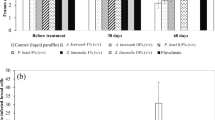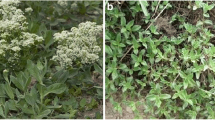Abstract
This experiment was conducted to evaluate acaricidal activity of the essential oils of Thymus kotschyanus, Ferula assa-foetida and Eucalyptus camaldulensis against Varroa destructor under laboratory conditions. Moreover, fumigant toxicity of these oils was tested on Apis mellifera. After preliminary dose-setting experiments, mites and honey bees were exposed to different concentrations of the oil, with 10 h exposure time. Essential oil of T. kotschyanus appeared the most potent fumigant for V. destructor (LC50 = 1.07, 95% confidence limit (CL) = 0.87–1.26 μl/l air), followed by E. camaldulensis (LC50 = 1.74, 95% CL = 0.96–2.50 μl/l air). The lowest acaricidal activity (LC50 = 2.46, 95% CL = 2.10–2.86 μl/l air) was attributed to essential oil of F. assa-foetida. Surprisingly, among the three oils tested, essential oil of T. kotschyanus had the lowest insecticidal activity against A. mellifera (LC50 = 5.08, 95% CL = 4.54–5.06 μl/l air). These findings proved that essential oil of T. kotschyanus has potential of practical value for use as alternative acaricide in the management of varroa in apiaries.

Similar content being viewed by others
References
Ariana A, Ebadi R, Tahmasbi GH (2002) Laboratory evaluation of some plant essences to control Varroa destructor (Acari: Varroidae). Exp Appl Acarol 27:319–327
Baker MD, Peng CYS (1995) Varroa jacobsoni and Tropilaelaps clareae: a perspective of life history and why Asian bee mite preferred european honey bees. Am Bee J 135:415–420
Bollhalder F (1998) Thymovar for Varroa control. Schweiz Bienen-Zeitung 121:148–151
Bowen-Walker PL, Gunn A (2001) The effect of the ectoparasitic mite, Varroa destructor on adult worker honeybee (Apis mellifera) emergence weights, water, protein, carbohydrate, and lipid levels. Entomol Exp Appl 101:207–217
Calderone NW, Spivak M (1995) Plant extracts for control of the parasitic mite Varroa jacobsoni (Acari: Varroidae) in colonies of the western honey bee (Hymenoptera: Apidae). J Econ Entomol 88:1211–1215
Chiasson H, Vincent C, Bostanian NJ (2004) Insecticidal properties of a Chenopodium-based botanical. J Econ Entomol 97:1378–1383
Chiesa F (1991) Effective control of varroatosis using powdered thymol. Apidologie 22:135–145
Choi WI, Lee SG, Park HM, Ahn YJ (2004) Toxicity of plant essential oils to Tetranychus urticae (Acari: Tetranychidae) and Phytoseiulus persimilis (Acari: Phytoseiidae). J Econ Entomol 97:553–558
Cimanga K, Kambu K, Tona L, Apers S, De Bruyne T, Hermans N, Totte J, Pieters L, Vlietnck AJ (2002) Correlation between chemical composition and antibactrial activity of essential oils of some aromatic medicinal plants growing in the Democratic republic of Congo. J Ethnopharmacol 79:213–220
Colin ME (1990) Essential oils of Labiatae for controlling honey bee varroosis. J Appl Entomol 110:19–25
Colin ME, Ciavarella F, Otero-Colina G, Belzunces LP (1994) A method for characterizing the biological activity of essential oils against Varroa jacobsoni. In: Matheson A (ed) New perspectives on Varroa, Int Bee Res Assoc. Cardiff, UK, pp 109–114
Dejong D, Dejong PH, Goncalves LS (1982) Weight loss and other damage to developing worker honey bees from infestation with Varroa jacobsoni. J Apic Res 1:165–167
Dimetry NZ, Abd El-wahab TE, Zakaria ME (2005) Effective control of Varroa destructor Anderson and Trueman infesting honey bee colonies Apis mellifera L. by some natural products. Bull Facul Agric Cairo Univ 56:295–308
Elzen PJ, Eischen FA, Baxter JR, Elzen GW, Wilson WT (1999) Detection of resistance in US Varroa jacobsoni Oud. (Mesostigmata: Varroidae) to the acaricide fluvalinate. Apidologie 30:13–17
Elzen PJ, Baxter JR, Elzen GW, Rivera R, Wilson WT (2000) Evaluation of grapefruit essential oils for controlling Varroa jacobsoni Oud. Infesting honey bee colonies. J Agric Sci Mansoura Univ 26:1055–1061
Enan E (2001) Insecticidal activity of essential oils: octopaminergic sites of action. Comp Biochem Physiol 130:325–337
Gal H, Slabezki Y, Lensky Y (1992) A preliminary report on the effect of origanum oil and thymol applications in honey bee (Apis mellifera L.) colonies in a subtropical climate on population levels of Varroa jacobsoni. Bee Sci 2:175–180
Hardman HF, Moore JI, Lum BKB (1959) A method for analyzing the effect of PH and ionization of drugs upon cardiac tissue with special reference to pentabarbitol. J Pharmacol Exp Ther 126:136–142
Imdorf A, Bogdanov S, Kilchenmann V, Maquelin C (1995a) APILIF VAR-A new varroacide with thymol as the main ingredient. Bee World 76:77–83
Imdorf A, Kilchenmann V, Bogdanov S, Bachofen B, Beretta C (1995b) Toxic effects of thymol, camphor, menthol and eucalyptol on Varroa jacobsoni Oud. and Apis mellifera L. in a laboratory test. Apidologie 26:27–31
Imdorf A, Bogdanov S, Ibañez Ochoa R, Calderone NW (1999) Use of essential oils for the control of Varroa jacobsoni in honey bee colonies. Apidologie 30:209–229
Imdorf A, Bogdanov S, Kilchenmann V, Berger T (2006) Toxic effects of essential oils and some of their components on Varroa destructor Oud. and Apis mellifera L under laboratory conditions. ALP Sci 495:3–18
Kraus B, Koeinger N, Fuchs S (1994) Screening of substances for their effect on Varroa jacobsoni: attractiveness, repellency, toxicity and masking effects of ethereal oils. J Apic Res 33:34–43
Kuperman AS, Gill EW, Riker WF (1961) The relationship between cholinesterase inhibition and drug-induced facilitation of mammalian neuromuscular transmission. J Pharmacol Exp Ther 132:65–73
Lee BH, Annis PC, Tumaalii F, Choi WS (2004) Fumigant toxicity of essential oils from the Myrtaceae family and 1, 8-cineol against 3 major stored-grain insects. J Stored Prod Res 40:553–564
Melathopoulos AP, Winston ML, Whittington R, Smith T, Lindberg C, Mukai A, Moore M (2000) Comparative laboratory toxicity of neem pesticides to honey bees (Hymenoptera: Apidae), their mite parasites Varroa jacobsoni (Acari: Varroidae) and Acarapis woodi (Acari: Tarsonemidae) and brood pathogens Paenibacillus larvae and Ascophaera apis. J Econ Entomol 93:199–209
Milani N (1995) The resistance of Varroa jacobsoni Oud. to pyrethroids: a laboratory assay. Apidologie 26:415–429
Nassar ME, Abu Mustafa A, Ahmed A (1995) Sesquiterpene coumarins from Ferula assa-foetida L. Pharmazie 50:766–767
Negahban M, Moharramipour S, Sefidkon F (2006) Insecticidal activity and chemical composition of Artemisia sieberi Besser essential oil from Karaj, Iran. J Asia Pac Entomol 9:61–66
Negahban M, Moharramipour S, Sefidkon F (2007) Fumigant toxicity of essential oil from Artemisia sieberi Besser against three stored-product insects. J Stored Prod Res 43:123–128
Robertson JL, Rappaport NG (1979) Direct, indirect and residual toxicity of insecticide sprays to western spruce budworm, Choristoneura occidentalis (Lepidoptera: Tortricidae). Can Entomol 111:1219–1226
Robertson JL, Russell RM, Preisler HK, Savin NE (2007) Bioassays with Arthropods. CRC Press, Boca Raton
Ruffinengo S, Eguaras M, Floris I, Faverin C, Bailac P, Ponzi M (2005) LD50 and repellent effects of essential oils from Argentinian wild plant species on Varroa destructor. J Econ Entomol 98:651–655
Ruffinengo S, Maggi M, Faverin C, Garcia DSB, Bailac P, Principal J, Eguaras M (2007) Essential oils toxicity related to Varroa destructor and Apis mellifera under laboratory conditions. Zootec Trop 25:63–69
Safaei-Ghomi J, Meshkatalsadat MH, Shamai S, Hasheminejad M, Hasani A (2009) Chemical characterization of bioactive volatile molecules of four Thymus species using nonsocial injection method. Dig J Nanomater Bios 4:835–841
Sammataro D, Degrandi-Hoffman G, Needham G, Wardell G (1998) Some volatile plant oils as potential control agents for Varroa mites (Acari: Varroidae) in honey bee colonies (Hymenoptera: Apidae). Am Bee J 138:681–685
Schenk P, Imdorf A, Fluri P (2001) Effects of neem oil on Varroa mites and bees. Am Bee J 141:878–879
Su YC, Ho CL, Wang EIC, Chang ST (2006) Antifungal activities and chemical compositions of essential oils from leaves of four eucalypts. Taiwan J For Sci 21:49–61
Tapondjou LA, Alder C, Bouda H, Fonten DA (2002) Efficacy of powder and essential oil from Chenopodium ambrosioidies leaves as post-harvest grain protectants against six-stored products beetles. J Stored Prod Res 38:395–402
Wallner K (1999) Varroacides and their residues in bee products. Apidologie 30:235–248
Wittington R, Winson ML, Melathopoulos AP, Higo HA (2000) Evaluation of the botanical oils neem, thymol and canola sprayed to control Varroa jacobsoni Oud. (Acari: Varroidae) and Acarapis woodi (Acari: Rarsonemidae) in colonies of honey bees (Apis mellifera L., Hymenoptera: Apidae). Am Bee J 140:567–572
Author information
Authors and Affiliations
Corresponding author
Rights and permissions
About this article
Cite this article
Ghasemi, V., Moharramipour, S. & Tahmasbi, G. Biological activity of some plant essential oils against Varroa destructor (Acari: Varroidae), an ectoparasitic mite of Apis mellifera (Hymenoptera: Apidae). Exp Appl Acarol 55, 147–154 (2011). https://doi.org/10.1007/s10493-011-9457-1
Received:
Accepted:
Published:
Issue Date:
DOI: https://doi.org/10.1007/s10493-011-9457-1




